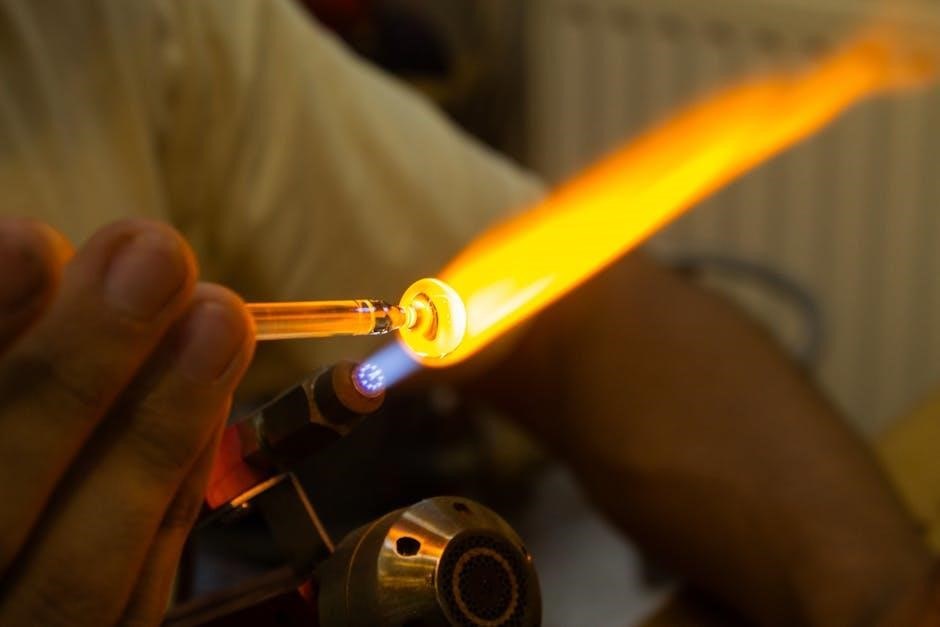The Honeywell Burner Controller Manual provides a comprehensive guide for installing, operating, and maintaining advanced burner control systems. It outlines essential features, safety protocols, and troubleshooting procedures, ensuring optimal performance and compliance with industry standards.
Overview of Honeywell Burner Controllers
Honeywell Burner Controllers are advanced systems designed to manage and monitor industrial combustion processes efficiently. These controllers, including the TBC2800 Series, 7800 Series, and DBC2000, offer precise control over fuel ignition, flame detection, and burner operation; They support various fuel types, including gas, oil, and combination fuels, ensuring versatility in industrial applications. Key features include adjustable timing settings, flame thresholds, and LED indicators for real-time status monitoring. The controllers also support pulse and modulating firing modes, enhancing operational flexibility. With robust safety standards and compliance certifications, Honeywell Burner Controllers are reliable solutions for industrial burner systems, ensuring optimal performance, safety, and energy efficiency in demanding environments.
Importance of the Manual for Users
The Honeywell Burner Controller Manual is an essential resource for users, providing detailed instructions for installation, operation, and maintenance. It ensures safe and efficient system operation by outlining safety precautions, configuration steps, and troubleshooting guidelines; The manual helps users understand system capabilities, such as flame detection types and adjustable settings, maximizing performance. It also serves as a reference for diagnosing and resolving common issues, minimizing downtime. By adhering to the manual’s recommendations, users can optimize burner controller functionality, ensuring compliance with industry standards and enhancing overall system reliability. Proper use of the manual is crucial for achieving intended safety and operational benefits in industrial environments.
Target Audience
The Honeywell Burner Controller Manual is primarily intended for professionals involved in the installation, operation, and maintenance of industrial burner systems. This includes engineers, technicians, and facility managers responsible for ensuring safe and efficient combustion processes. The manual is also useful for safety officers, compliance specialists, and system integrators who oversee industrial automation and control systems. Additionally, it serves as a reference for training personnel and operators who need to understand burner controller functionality and troubleshooting. The manual’s detailed guidance ensures that all users can maximize system performance while adhering to safety standards and operational best practices. It is an indispensable resource for anyone working with Honeywell burner controllers in industrial environments.

Honeywell TBC2800 Series Burner Controller
The Honeywell TBC2800 Series is a advanced burner controller designed for industrial applications, offering compatibility with UV, double rod, and single rod flame detection systems.
Features and Capabilities

The Honeywell TBC2800 Series offers a range of advanced features, including compatibility with UV, double rod, and single rod flame detection systems. It provides adjustable timing settings and flame thresholds, allowing for precise control over burner operations. The controller is equipped with LED indicators for status and fault notifications, ensuring clear communication of system states. With an IP54 protection rating, it is designed to withstand harsh industrial environments. The TBC2800 supports both pulse and modulating firing modes, making it versatile for various industrial applications. Additionally, it can be installed remotely or on-site, offering flexibility in system design and integration.
Flame Detection Types
Honeywell burner controllers support various flame detection methods, including UV, double rod, and single rod systems. UV detection offers high reliability by sensing ultraviolet radiation from flames, minimizing interference from other light sources. Double rod detection uses two electrodes to ensure accurate flame presence verification, reducing false negatives. Single rod detection provides a cost-effective solution for simpler applications. Each method ensures safe and efficient burner operation, with the controller adapting to the selected detection type; These options cater to different industrial requirements, providing flexibility and reliability in burner management systems. Proper flame detection is critical for safety, and Honeywell’s controllers are designed to integrate seamlessly with these technologies.

Adjustable Timing and Flame Thresholds
Honeywell burner controllers feature adjustable timing and flame thresholds, allowing users to fine-tune settings for optimal performance. Timing parameters, such as ignition and post-purge durations, can be customized to match specific burner requirements. Flame thresholds are adjustable to ensure accurate detection, accommodating varying fuel types and operating conditions. These adjustments enhance system reliability and safety, minimizing false alarms and ensuring proper combustion. The controller’s flexibility supports a wide range of industrial applications, from small-scale operations to large, complex systems. By tailoring these settings, users can achieve precise control over burner operation, ensuring efficiency and compliance with safety standards. This adaptability makes Honeywell controllers versatile and reliable for diverse industrial needs.
LED Indicators and Protection Ratings
Honeywell burner controllers are equipped with LED indicators that provide real-time status updates, enabling quick visual monitoring of system operations. These LEDs indicate power status, flame detection, fault conditions, and operational modes, ensuring users can identify issues at a glance. The controllers also feature robust protection ratings, such as IP54, which safeguards against dust ingress and water splashes, ensuring reliability in harsh industrial environments. Additionally, these units are designed with surge protection and voltage withstand capabilities, enhancing durability and performance. The combination of clear visual feedback and rugged construction makes Honeywell burner controllers a dependable choice for demanding applications, providing both functionality and long-term reliability.

Honeywell 7800 Series Relay Modules
The Honeywell 7800 Series Relay Modules offer advanced control solutions for industrial burner systems, providing reliable flame safeguarding and compatibility with various burner configurations and fuel types.
Model Overview and Compatibility
The Honeywell 7800 Series Relay Modules are designed for compatibility with a wide range of industrial burner systems, supporting both gas and oil-fired applications. These modules are part of a comprehensive control system that ensures safe and efficient burner operation. With microprocessor-based technology, they offer advanced features such as real-time monitoring and diagnostics. The series includes models like the RM7800, which can be integrated with various display modules for enhanced user interaction. Compatibility with different burner configurations makes the 7800 Series a versatile solution for industrial heating applications, ensuring adherence to safety standards and optimal performance across diverse operational environments.
Configuration and Modes of Operation
The Honeywell 7800 Series Relay Modules offer flexible configuration options to suit various industrial burner applications. These modules support multiple modes of operation, including on/off, pulse, and modulating firing, allowing for precise control of burner performance. Users can configure the system to meet specific requirements, such as fuel type (gas, oil, or combination) and burner capacity. The modules are designed for easy integration with other components, ensuring seamless operation. With advanced microprocessor-based technology, the 7800 Series provides real-time monitoring and diagnostics, enhancing system reliability. Configuration can be tailored to comply with safety standards, ensuring optimal efficiency and performance in diverse industrial environments.
Display Modules for Enhanced Interaction
Honeywell’s 7800 Series Burner Controller System incorporates display modules that enhance user interaction through real-time data visualization. The S7800A Keyboard Display Module features a 2-line LCD screen, providing clear visibility of burner status, fault codes, and system parameters. This module allows users to navigate through menus effortlessly, facilitating quick troubleshooting and adjustments. Additional display options, such as graphical interfaces, offer detailed insights into operational data, enabling precise monitoring and control. These modules are designed to streamline operator interactions, improving overall system efficiency and reducing downtime. By integrating intuitive display solutions, Honeywell ensures that users can access critical information instantly, making the burner control system both user-friendly and highly functional.
Safety Standards and Compliance
Honeywell’s burner controller systems are designed to meet rigorous safety standards and regulatory requirements. The 7800 Series, classified as a Type B1 element under IEC 61508, ensures high reliability and fault tolerance in industrial applications. These controllers comply with global safety certifications, guaranteeing safe operation across various fuel types. Features like emergency shutdown procedures and fault detection align with industry protocols to prevent hazards. Compliance with environmental and disposal standards ensures eco-friendly practices. By adhering to these standards, Honeywell burner controllers provide a secure and reliable solution for industrial burner systems, prioritizing operator safety and system integrity while meeting all necessary legal and environmental obligations.

Honeywell DBC2000 Burner Controller
The Honeywell DBC2000 is a microprocessor-based integrated burner controller designed for gas, oil, or combination fuel industrial single burner applications, offering advanced control and monitoring capabilities.
Microprocessor-Based Integrated Control
The Honeywell DBC2000 features a microprocessor-based integrated control system, enabling precise automation for industrial burners. It supports gas, oil, and combination fuel systems, ensuring efficient combustion control and safety. The microprocessor handles advanced monitoring, diagnostics, and adaptive control, optimizing burner performance. Real-time data processing allows for quick fault detection and troubleshooting. The system integrates seamlessly with external devices, offering flexibility in industrial applications. Its robust design ensures reliability in harsh environments, adhering to industry safety standards. This control system is designed to minimize downtime and enhance operational efficiency, making it a reliable choice for modern industrial burner management.
Fuel Compatibility and Applications
The Honeywell DBC2000 burner controller is designed for compatibility with a wide range of fuels, including natural gas, propane, diesel, and fuel oils. This versatility makes it suitable for various industrial applications, such as boilers, process heaters, and ovens. The controller’s adaptive technology ensures optimal performance across different fuel types, while maintaining safety and efficiency. It is particularly ideal for single-burner systems in power generation, chemical processing, and food production industries. The DBC2000’s fuel compatibility and robust design make it a reliable solution for diverse industrial combustion needs, ensuring consistent and high-performance operation in demanding environments.
Installation Recommendations
- Ensure the controller is installed in a clean, dry, and well-ventilated area to protect against dust and moisture.
- Mount the device on a stable surface, away from direct sunlight and heat sources, to prevent overheating.
- Install the controller within the recommended temperature range of 0°C to 60°C to ensure optimal performance.
- Avoid exposing the device to excessive moisture, as the maximum moisture rating applies only up to 40°C.
- Secure all electrical connections tightly and ensure compliance with local electrical codes to prevent hazards.
Environmental and Moisture Considerations
The Honeywell burner controller is designed to operate effectively in various environmental conditions, but proper precautions are essential to ensure longevity and reliability. The controller should be installed in areas with minimal exposure to direct sunlight, extreme temperatures, and humidity. Condensation can damage internal components, so avoid placing the unit in damp environments. For optimal performance, maintain an operating temperature range of 0°C to 60°C and relative humidity below 80%. Use protective enclosures in high-moisture areas to prevent corrosion; Regularly clean the controller to remove dust and debris, which can impede airflow and functionality. Always store the controller in a dry, cool place when not in use to prevent damage.

Installation and Configuration
Proper installation and configuration of Honeywell burner controllers ensure safe and efficient operation. Follow manual guidelines for wiring, electrical connections, and compliance with local codes.
General Installation Requirements
General installation requirements for Honeywell burner controllers emphasize adherence to manufacturer specifications. Ensure the controller is installed in a dry, well-ventilated area, away from direct sunlight and moisture. Proper grounding is essential to prevent electrical interference and ensure safety. The controller should be mounted securely to a flat surface using the provided hardware. Additionally, all connections must comply with local electrical codes and regulations. It is crucial to follow the manual’s guidelines for wiring and power supply to avoid malfunctions. Regular inspection of the installation site ensures optimal performance and longevity of the burner control system. Always refer to the manual for specific installation details.
Wiring and Electrical Connections
Proper wiring and electrical connections are critical for the safe and efficient operation of Honeywell burner controllers. All wiring must be carried out by qualified personnel, adhering to the manual’s specifications and local electrical codes. Use appropriately rated cables to ensure compatibility with the controller’s voltage and current requirements. Verify polarity and phase sequencing to prevent damage or malfunction. Grounding must be done correctly to eliminate electrical noise and ensure safety. Double-check all connections before powering up the system. Use the provided wiring diagrams in the manual for accurate configurations. Regularly inspect wires for wear or damage to maintain system integrity and performance.
Remote Installation Options
Honeywell burner controllers offer flexible remote installation options to suit various industrial setups. Remote mounting allows the controller to be placed away from the burner, reducing heat exposure and enhancing accessibility. Use shielded cables to minimize electrical interference during remote connections; Ensure all components are compatible with remote operation, as specified in the manual. Configure remote alarms and indicators for real-time monitoring. Regularly test communication lines to maintain system reliability. Adhere to environmental guidelines, such as moisture and temperature limits, to prevent damage. Remote installation simplifies maintenance and troubleshooting, ensuring continuous operation in demanding industrial environments. Always follow Honeywell’s installation guidelines for optimal performance and safety.
Initial Setup and Calibration
The initial setup and calibration of Honeywell burner controllers require careful attention to ensure proper functionality and safety. Begin by powering the system and configuring the controller according to the burner type and fuel source. Use the digital interface to set flame thresholds and timing parameters, ensuring they align with the burner’s specifications. Test communication lines between the controller and remote devices to confirm connectivity. Perform a full system check, including ignition, flame detection, and shutdown sequences, to verify correct operation. Refer to the manual for specific calibration procedures and safety protocols. Proper setup ensures accurate performance, reduces risks, and extends equipment lifespan. Always follow manufacturer guidelines for optimal results.

Operational Features
Honeywell burner controllers offer advanced operational features, including pulse and modulating firing modes, real-time monitoring, and diagnostics, ensuring precise control and compliance with safety standards.
Pulse and Modulating Firing Modes
Honeywell burner controllers support pulse and modulating firing modes, enabling precise combustion control. Pulse firing mode operates the burner in fixed cycles, optimizing energy use and reducing wear. Modulating firing allows continuous burner operation, adjusting fuel and air flow to match demand. Both modes ensure efficient combustion, lower emissions, and improved system performance. These features are crucial for industrial applications, providing flexibility and reliability in various operating conditions while maintaining safety and compliance with industry standards.
Real-Time Monitoring and Diagnostics
Honeywell burner controllers offer advanced real-time monitoring and diagnostics, providing users with immediate insights into system performance. The systems display live operational data, including burner status, fuel flow, and temperature levels, allowing for precise adjustments. Diagnostic tools enable quick identification of faults, such as ignition failures or sensor malfunctions, reducing downtime. Integrated logging features store historical data for trend analysis and troubleshooting. These capabilities ensure optimal system efficiency, safety, and reliability, making it easier to maintain and repair burner controllers in industrial settings. Real-time diagnostics also support predictive maintenance, helping to prevent issues before they occur.
Fault Detection and Alarms
Honeywell burner controllers incorporate sophisticated fault detection systems, providing immediate alerts for operational issues. The controllers monitor critical parameters like flame presence, gas flow, and system pressure. Upon detecting anomalies, they trigger visual and audible alarms, ensuring prompt intervention. Detailed fault codes stored in the system aid in quick diagnosis. These features minimize risks of burner failure and enhance safety. Alarms can be customized to suit specific applications, ensuring tailored notifications for various scenarios. The system’s robust fault detection ensures reliable operation, reducing the likelihood of accidents and downtime in industrial environments. This advanced monitoring supports safer and more efficient burner management.
User Interface Navigation
The Honeywell burner controller’s user interface is designed for intuitive navigation, ensuring easy access to critical functions and settings. The display modules, such as the S7800A Keyboard Display Module, feature a 2-line LCD screen that provides real-time burner status, fault codes, and system parameters. This interface allows users to quickly troubleshoot issues and monitor operations. The menu-driven system simplifies configuration and adjustments, reducing complexity for technicians. Enhanced interaction tools enable seamless navigation between diagnostic screens and operational modes. The user-friendly design ensures that operators can efficiently manage burner systems, minimizing downtime and optimizing performance. This accessibility makes the Honeywell controller a reliable choice for industrial applications, supporting both novice and experienced users.

Troubleshooting and Maintenance
Troubleshooting involves identifying common issues like blocked pressure switches or ignition faults. Regular maintenance ensures optimal performance, with diagnostic tools aiding quick fault resolution and system reliability.
Common Issues and Solutions
Common issues with Honeywell burner controllers include faulty flame detection, incorrect wiring, and blocked pressure switches. Resetting the system or cleaning components often resolves these problems. For flame detection issues, ensure proper UV or rod alignment. Incorrect wiring should be checked against the manual. Blocked pressure switches can be cleared by inspecting and cleaning the hose. Regular maintenance, such as updating software and replacing worn parts, prevents recurring issues. If problems persist, consult diagnostic tools or contact Honeywell support for assistance. Proper troubleshooting ensures safe and efficient burner operation, minimizing downtime and extending system lifespan.
Diagnostic Tools and Techniques
Honeywell burner controllers offer advanced diagnostic tools to identify and resolve issues efficiently. The S7800A Keyboard Display Module provides real-time burner status, fault codes, and system parameters, enabling quick troubleshooting. LED indicators on the controller signal operational status and faults, aiding in visual diagnostics. Users can utilize multimeters to check electrical connections and voltage levels, ensuring proper installation and function. Regular software updates and system checks are recommended to maintain optimal performance. By leveraging these tools, technicians can pinpoint problems, such as faulty flame detection or incorrect wiring, and apply targeted solutions to ensure reliable operation and safety. Proper diagnostics extend system lifespan and prevent unexpected downtime.
Regular Maintenance Schedule
Regular maintenance is crucial to ensure the optimal performance and longevity of Honeywell burner controllers. Users should schedule periodic inspections of flame detectors, wiring, and electrical connections to prevent faults. Cleaning the controller’s exterior and internal components, such as fans and vents, is recommended to avoid dust buildup and overheating. Additionally, checking for software updates and installing the latest versions ensures compatibility and enhanced functionality. Routine testing of safety features, such as emergency shutdown procedures, is essential to maintain compliance with safety standards. Adhering to the recommended maintenance schedule outlined in the manual helps prevent unexpected downtime and ensures reliable operation of the burner control system. Proper care extends the lifespan of the controller and maintains operational efficiency. Regular maintenance also supports environmental considerations, such as moisture protection ratings, by ensuring the system operates within specified limits. By following Honeywell’s guidelines, users can safeguard their investment and ensure consistent performance.
Replacement Parts and Supplies
Honeywell offers a range of genuine replacement parts and supplies for burner controllers, ensuring compatibility and optimal performance. Users can source these parts directly from Honeywell’s official website or authorized distributors. Replacement components include flame detectors, wiring harnesses, and control modules, all designed to meet specific system requirements. It is crucial to use genuine Honeywell parts to maintain safety, reliability, and compliance with industry standards. Before purchasing, users should verify part numbers and compatibility with their controller model. Proper installation of replacement parts should follow the manual’s guidelines to avoid malfunctions. Honeywell also provides diagnostic tools and technical support to assist with identifying and procuring the correct supplies. Regularly updating or replacing worn-out components ensures uninterrupted operation and extends the lifespan of the burner control system. Always refer to the manual for a detailed list of recommended replacement parts and suppliers.

Safety Precautions and Compliance
Adhere to safety guidelines to ensure proper installation and operation. Comply with industry standards and regulations for burner control systems to maintain reliability and prevent hazards. Always follow Honeywell’s specific safety protocols and certification requirements for optimal performance and legal compliance. Regular inspections and adherence to environmental disposal practices are also essential. Proper safety measures protect both personnel and equipment, ensuring a secure working environment. Compliance with standards like IEC 61508 guarantees system reliability and safety in industrial applications.
General Safety Guidelines
Always follow Honeywell’s safety guidelines to ensure safe installation and operation of burner controllers. Wear appropriate protective equipment, including gloves and safety glasses, when handling electrical components. Ensure proper ventilation in the area to prevent accumulation of flammable gases. Never bypass safety features or disable alarms, as this can lead to hazardous conditions. Regularly inspect all connections and components for signs of wear or damage. Keep the area clear of combustible materials and follow all local fire safety regulations. Only qualified personnel should perform maintenance or repairs. Refer to the manual for specific safety precautions related to your model. Comply with industry standards and regulations to maintain a safe working environment. Report any malfunctions immediately to prevent potential risks. Store replacement parts and supplies in a secure, dry location. Dispose of hazardous materials according to environmental guidelines. Understand emergency procedures before operating the system. Test safety devices periodically to ensure they function correctly. Use only approved tools and equipment for installation and maintenance tasks. Label all components clearly for easy identification. Document all safety protocols and ensure they are accessible to all personnel. Conduct routine safety audits to identify and address potential risks. Provide training to all users on safety procedures and system operation. Monitor system performance regularly to prevent unexpected shutdowns or failures. Have a emergency contact list readily available in case of incidents. Ensure all electrical connections meet local codes and standards. Use grounding techniques to prevent electrical shocks. Follow proper lockout/tagout procedures during maintenance. Be aware of the system’s environmental limitations, such as temperature and humidity ranges. Keep the manual accessible for quick reference during emergencies. Stay informed about updates and revisions to safety guidelines. Collaborate with safety professionals to ensure compliance with all regulations. Implement a preventive maintenance schedule to uphold safety standards. Use only Honeywell-approved replacement parts to maintain system integrity. Ensure proper signage is in place to warn of potential hazards. Prepare for power outages with backup systems or procedures. Test emergency shutdown mechanisms to confirm functionality. Review incident reports to identify recurring safety issues. Engage in continuous safety training to stay updated on best practices. Inspect fire suppression systems regularly to ensure readiness. Monitor gas lines for leaks and damage. Ensure proper ventilation to prevent gas buildup. Use explosion-proof equipment in hazardous areas. Avoid overloading circuits to prevent electrical failures. Label emergency exits clearly and ensure they are unobstructed. Store flammable materials away from heat sources. Use proper lifting techniques to prevent injuries. Ensure adequate lighting in work areas. Prevent unauthorized access to the control system. Document all safety incidents for future reference. Conduct regular fire drills to prepare for emergencies. Ensure all personnel understand emergency procedures. Use personal protective equipment as required by the task. Follow proper chemical handling procedures when applicable. Ensure all safety devices are functioning correctly. Stay alert and focused while performing tasks. Communicate hazards to all relevant personnel. Use safety data sheets for all chemicals involved. Prevent electrical overloads by managing power usage. Ensure all tools are in good condition before use. Follow proper first aid procedures in case of accidents. Keep emergency contact information updated and accessible. Conduct safety meetings to discuss potential risks. Implement a spill response plan for hazardous materials. Ensure all safety equipment is easily accessible. Monitor weather conditions that could affect safety. Use proper ergonomic practices to prevent injuries. Stay informed about safety regulations and updates. Ensure all safety protocols are followed consistently. Prepare for natural disasters with a contingency plan. Test safety systems regularly to ensure reliability. Document all maintenance activities for compliance. Ensure all personnel are trained on safety procedures. Use only approved safety equipment for each task. Monitor for signs of fatigue among personnel. Ensure proper use of fire extinguishers in the area. Stay vigilant for potential hazards at all times. Implement a safety reward program to encourage compliance. Conduct safety audits to identify and correct issues. Ensure all safety measures are clearly communicated. Stay proactive in addressing potential safety risks. Use technology to enhance safety monitoring and reporting. Ensure all safety standards are met or exceeded. Prepare for emergencies with a well-planned response. Stay committed to continuous safety improvement. Ensure all safety guidelines are up to date. Take all necessary precautions to protect personnel and equipment. Always prioritize safety in all operations and maintenance tasks. Ensure a safe working environment through compliance and preparedness.
Emergency Shutdown Procedures
In case of an emergency, immediately activate the emergency shutdown button to halt all burner operations. Isolate the fuel supply to prevent any further ignition sources. Use the fire suppression system if a fire occurs. Evacuate the area and ensure all personnel are safe. Do not attempt to restart the system until a thorough inspection confirms it is safe to do so. Follow the manual’s specific shutdown procedures for your Honeywell burner controller model. Contact a qualified technician to assess and repair any issues before resuming operation. Document the incident for future reference and to comply with safety regulations. Ensure all safety protocols are strictly followed during and after the shutdown process.
Industry Certifications and Standards
Honeywell burner controllers adhere to global industry certifications and standards, ensuring reliability and safety. They comply with IEC 61508 for functional safety and ISO 9001 for quality management. These certifications guarantee that the controllers meet rigorous international benchmarks. Additionally, Honeywell products are designed to comply with RoHS (Restriction of Hazardous Substances) and other environmental regulations. Compliance with these standards ensures that the controllers are not only safe but also environmentally responsible. Third-party testing further verifies their performance and durability. By meeting these certifications, Honeywell burner controllers provide users with confidence in their reliability and adherence to global safety and environmental guidelines, making them suitable for industrial applications worldwide.
Environmental and Disposal Considerations
Honeywell burner controllers are designed with environmental responsibility in mind. The devices are built to minimize energy consumption and reduce operational waste. For disposal, it is crucial to follow local regulations and guidelines for electronic waste. Components such as batteries and circuit boards must be handled according to RoHS standards to prevent hazardous materials from entering the environment. Users are encouraged to recycle these products through certified facilities. Proper disposal ensures environmental protection and adherence to sustainability practices. Always refer to regional laws and Honeywell’s specific recommendations for eco-friendly disposal methods to minimize the product’s environmental footprint.
